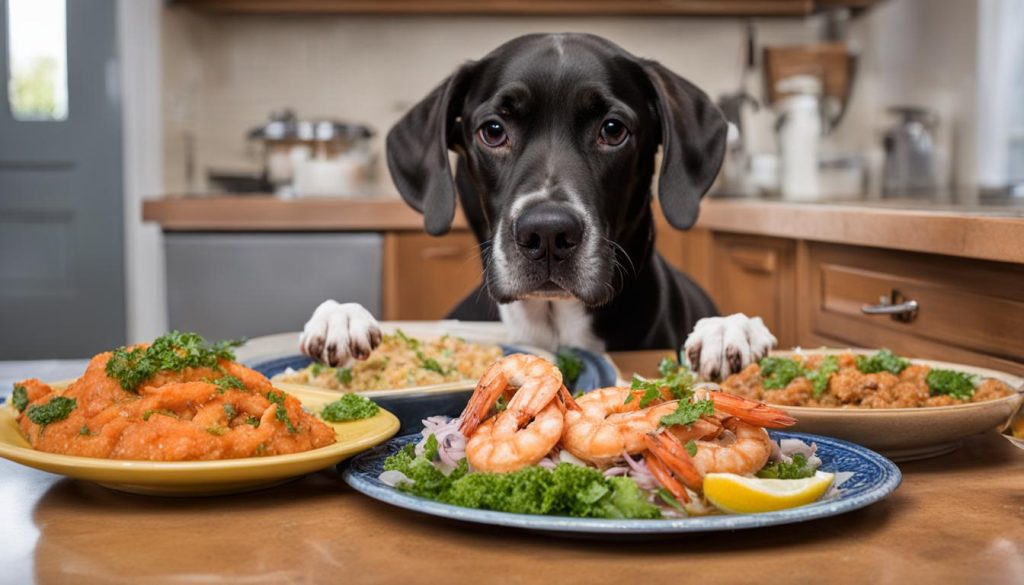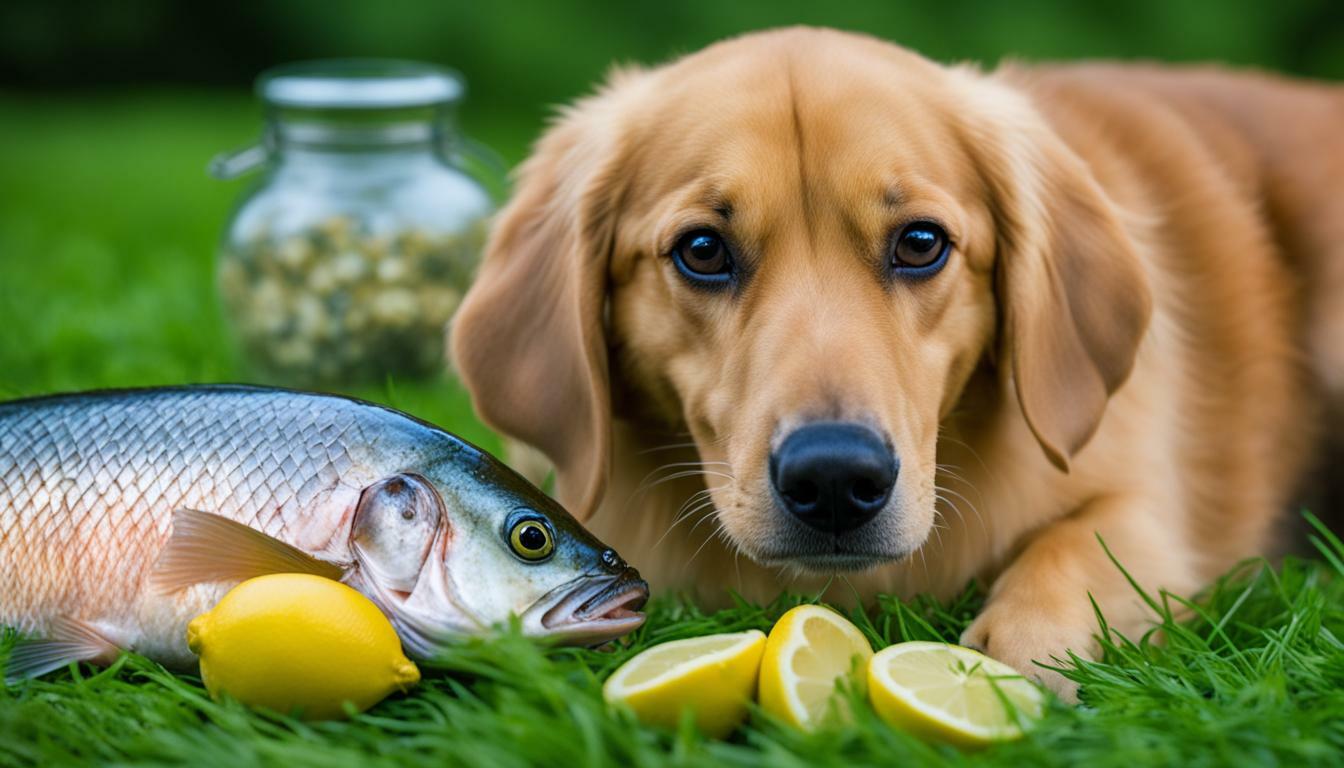As I settle down with my evening snack, a curious pair of eyes begs the question in my mind: can dogs eat shrimp? Amid the array of human treats, pet owners often ponder over what is safe to share with their four-legged pals. Let me dive into the answer that many dog enthusiasts are eager to find out. Yes, indeed, shrimp for dogs can be more than just a delicacy; it’s a treasure trove of protein and essential nutrients, ideal for dogs when fed in the right way.
My experience with feeding dogs shrimp begins with ensuring the shrimp are fully cooked to eliminate any harmful bacteria. Like many dog parents, I understand that moderation is key. This is why shrimp serves as an occasional booster packed with benefits, rather than a meal replacement. Treating my pup to shrimp as a dog treat now and then, after all, could bring a wave of tail wags and grateful licks.
Can Dogs Eat Shrimp? Yes, they can, But be sure that it is properly prepared.
- Cooked shrimp can be a nutritious and tasty treat for canines.
- Proper shrimp preparation is essential to avoid bacterial infection.
- Feed shrimp to dogs in moderation to prevent overfeeding.
- Remove all shrimp shells to eliminate choking risks.
- Always consult with your vet before introducing shrimp to your dog’s diet.
Decoding the Benefits of Shrimp in a Dog’s Diet
As someone who’s always looking out for my dog’s nutritional needs, I’ve found that incorporating shrimp into their diet can be advantageous. Understanding the benefits of shrimp for dogs is important not just because it’s a tasty treat they’ll love, but it plays a role in promoting optimal health.
One of the key reasons to consider shrimp in a dog’s diet is its significant protein content. My pup needs protein to uphold strong muscles, and with shrimp, they’re getting roughly 24 grams of high-quality protein per 100 grams. But the perks don’t stop there. Aiding in various bodily functions, shrimp is also filled with a suite of vitamins and essential minerals.
Nutritional Pros: Protein and Omega-3 Fatty Acids
Many of us are aware that omega-3 fatty acids are a cornerstone for maintaining a healthy canine coat and skin. Including shrimp occasionally can bolster these benefits, which is why I find dogs and shrimp can be such a beneficial pairing when done correctly. Not to mention, these fatty acids are known for their anti-inflammatory properties, contributing to overall health and well-being.
Vitamins and Minerals Essential for Canine Health
It’s not all about protein and fats; when I feed shrimp to my dog, they’re also getting a dose of vitamins B and C, iron for their bloodstream, magnesium for nerve function, and potassium to keep their heart healthy. Navigating my dog’s nutrition, I ask myself, “is shrimp safe for dogs?” and the answer is yes, provided it’s offered in proper amounts and prepared safely. It’s clear that shrimp has a nutritional profile that can support my dog in multiple facets of their health.
Can Dogs Eat Shrimp: Understanding the Risks
As someone who cares deeply for their furry friend, I’m always vigilant about what foods cross their path and shrimp is certainly no exception. It’s tempting to share our favorite treats with our dogs, yet it’s my responsibility to weigh the benefits against the potential risks. When it comes to the topic of can dogs have shrimp, it’s not a simple yes or no answer.
Addressing the Cholesterol Content
Shrimp may be a delectable seafood favorite for many of us, but we cannot overlook that it is also high in cholesterol. In moderation, shrimp can be a part of a dog’s diet; however, I am extra cautious with breeds known to face heart-related conditions, as an excessive intake stands a chance to exacerbate health issues like congestive heart failure. When sharing this crustacean with my dog, I ensure the portions are minimal to mitigate risks of dogs eating shrimp down the line.
Potential for Allergic Reactions to Shellfish in Dogs
Some dogs lick their bowl clean without a hitch after a shrimp treat, but it’s important to understand that shrimp allergies in dogs, albeit rare, are a serious concern. Monitoring my dog closely after introducing shrimp or any shellfish is crucial. If symptoms such as breathing difficulties, itchiness, or upset stomach occur, seeking immediate veterinary attention is paramount. Tailoring my dog’s diet to their specific needs helps keep potential adverse reactions at bay.

Proper Preparation: How to Safely Serve Shrimp to Your Pooch
When I consider treating my furry friend to a yummy seafood snack, the question inevitably crosses my mind: can dogs eat shrimp? It’s a treat I know they might love, but it’s crucial to focus on safe shrimp preparation for dogs. Let’s get into the nitty-gritty of cooking shrimp for dogs the right way to ensure their tails keep wagging.
For starters, raw shrimp is absolutely off the table. It can harbor bacteria that are harmful to both humans and dogs. Cooking it thoroughly is essential—a good boil or steam will do the trick to make shrimp safe for our canine pals. You’ll know it’s done when it shifts from its raw gray and translucent state to an opaque white and pink.
Would you like fries with that? Not for Spot! Serving shrimp plain is best, without any spices or seasoning, especially the ones that contain garlic or onions which are toxic to dogs. It’s also vital to remember to remove the shrimp head, tail, and shell, which could pose choking risks or digestive issues.
Even after proper preparation, it’s a good idea to introduce shrimp in small quantities. A dog’s digestive system might be sensitive to new foods, so watch for any signs of food intolerance or allergies. In the end, it’s all about moderation and safety—not to mention, seeing your pooch happy and healthy!
Quantifying a Safe Serving: Shrimp Portion Control for Different Dog Sizes
As a devoted dog owner, I’m always careful about my furry friend’s diet, particularly when it comes to human foods like shrimp. Knowing the precise serving sizes for dogs is essential, especially since feeding dogs shrimp comes with its own set of guidelines. While it’s established that can dogs eat shrimp, the real question is how much shrimp is too much? Let’s dive into the specifics of shrimp portion control to make sure our canine pals enjoy this treat without any health setbacks.
Considerations for Small and Toy Breeds
Small and toy breeds such as Yorkshire Terriers or Chihuahuas have different dietary needs than their larger counterparts. These tiny pooches require only a small quantity of shrimp to prevent overfeeding. A small dog could do well with even just a half shrimp as a treat to complement their regular meals. It’s pivotal to chop the shrimp into fine pieces to facilitate easier digestion and prevent any choking hazards.
Feeding Guide for Medium to Large Breed Dogs
When it comes to medium to large breeds like Boxers or Labradors, the shrimp serving size increases accordingly. These dogs can handle a couple of whole shrimp, depending on their size and weight. Nevertheless, even for larger breeds, shrimp must be given sparingly to maintain a balanced diet and prevent any digestive issues. Again, consulting with a vet for personalized advice based on your dog’s health is invaluable.

While shrimp can be a healthy snack for dogs, portion control is key. Whether you have a sprightly Spaniel or a gentle Giant Schnauzer, being mindful of the serving size will ensure that shrimp remains a safe and enjoyable treat. Always remember, when in doubt, check with your vet to ensure your dog’s safety and well-being.
Shrimp Alternatives and Varieties: Expanding Your Dog’s Seafood Palate
When I consider what’s best for my furry friend’s diet, I often explore beyond typical dog food, aiming for a variety of tastes and nutrients. That’s why I’ve become curious about alternatives to shrimp for dogs, especially when seeking to add a touch of seafood to their meals. Let’s face it, not all pups can handle shrimp, but that doesn’t mean they have to miss out on the bounty of the sea!
I’ve found that, yes, dogs can eat shellfish like scallops and other non-shrimp crustaceans. These seafood options have similar nutritional benefits—high in protein and omega-3 fatty acids, which are wonderful for maintaining a healthy coat and supporting joint health. However, it’s paramount to remember that these alternative shellfish treats must be properly cooked and offered plain, without any potentially harmful seasonings.
Now, I understand that some dog parents might be cautious about including seafood for dogs in their diet plans. In that case, I turn to dog-safe fruits and vegetables, or even some of the high-quality commercially available dog food toppers that replicate the taste of the sea without the worry. They’re convenient, safe, and often come approved by veterinarians—making them a fantastic shrimp substitute.
Ultimately, it’s about creating a diet that’s as diverse and rich in nutrients as it is appetizing for your dog. By considering shrimp alternatives and varieties of other seafood treats, you’re not just sticking to monotonous meal plans but promoting a happy and healthy lifestyle for your four-legged companion.
Conclusion
Wrapping up our exploration into whether can dogs eat shrimp, it’s clear that shrimp for dogs is not only a tantalizing choice but also a potential boost to their diet when given as a snack. I’ve gathered that incorporating shrimp into our dog’s diet can deliver a range of nutrients beneficial to their health. However, while they offer a source of protein and omega-3 fatty acids, shrimp should not replace a dog’s primary nutritional sources.
Revisiting the Question: Can Dogs Have Shrimp?
I’ve learned that dogs can indeed savor shrimp, as long as they’re prepared correctly—meaning fully cooked and devoid of any shells or tails. Portion control is key; our canine friends should only have these sea morsels in small quantities. I’m also mindful of keeping my dog’s diet balanced and consulting my vet to confirm that my choices are promoting a safe and nutrient-rich canine diet.
Solidifying a Safe and Nutrient-Rich Diet for Your Canine Companion
As a responsible pet owner, my goal is to ensure my dog’s diet is both safe and packed with nutrition. A safe inclusion of shrimp can indeed contribute to such a diet, but as I’ve understood, moderation is paramount. Whether it’s shrimp for dogs or any new dietary addition, my priority will always be to consult with my vet and follow their guidance, safeguarding the health and happiness of my furry companion.
FAQ
Can dogs eat shrimp?
Yes, dogs can eat shrimp if it is properly cooked and served in moderation. Shrimp should be cooked thoroughly to avoid the risk of bacterial infections and served plain without any harmful spices or seasonings.
What are the benefits of shrimp in a dog’s diet?
Shrimp is low in calories and high in protein, which is beneficial for muscle development in dogs. It also contains omega-3 fatty acids for a healthy coat and skin, and is a good source of vitamins and minerals essential for canine health.
Are there any risks associated with feeding dogs shrimp?
The primary risks include the potential for high cholesterol levels in shrimp to contribute to health issues in dogs, as well as the possibility of allergic reactions to shellfish. It’s important to monitor your dog for any signs of intolerance or allergy when introducing shrimp to their diet.
How should shrimp be prepared for dogs?
Shrimp should be fully cooked, either boiled or steamed, until it turns opaque white and pink. It’s essential to remove all parts of the shell, including the head and tail, to prevent choking hazards. Serve the shrimp plain, without any added seasonings.
How much shrimp can a dog safely consume?
The amount of shrimp a dog can safely consume depends on their size and breed. Generally, small or toy breeds should have smaller portions compared to medium and large breeds. Treats should make up no more than 10% of your dog’s diet, and it’s always best to consult with a veterinarian to determine the right serving size.
Are there other seafood alternatives safe for dogs?
Yes, in addition to shrimp, dogs can safely eat other seafood like shellfish and scallops, as long as they are cooked properly and served in moderation. As with shrimp, it’s important to ensure these are prepared without any harmful seasonings and introduced into the dog’s diet gradually while watching for any adverse reactions.
How can I ensure a safe and nutrient-rich diet for my dog?
To ensure a safe and nutrient-rich diet for your dog, consult with a veterinarian to tailor dietary inclusions like shrimp to your pet’s specific needs. Introduce new foods slowly and monitor for any health issues. Aim for a balanced diet that mainly consists of high-quality commercial dog food, supplemented with treats like shrimp occasionally.






